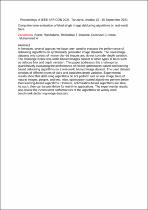 ResearchSpace
ResearchSpace
Comprehensive evaluation of blind single image deblurring algorithms on real-world blurs
JavaScript is disabled for your browser. Some features of this site may not work without it.
- ResearchSpace
- →
- Research Publications/Outputs
- →
- Conference Publications
- →
- View Item
| dc.contributor.author |
Zandamela, Frank

|
|
| dc.contributor.author |
Ratshidaho, Thikhathali T

|
|
| dc.contributor.author |
Kunene, Dumisani C

|
|
| dc.contributor.author |
Nana, Muhammad A

|
|
| dc.date.accessioned | 2021-11-26T08:45:31Z | |
| dc.date.available | 2021-11-26T08:45:31Z | |
| dc.date.issued | 2021-09 | |
| dc.identifier.citation | Zandamela, F., Ratshidaho, T.T., Kunene, D.C. & Nana, M.A. 2021. Comprehensive evaluation of blind single image deblurring algorithms on real-world blurs. http://hdl.handle.net/10204/12178 . | en_ZA |
| dc.identifier.isbn | 978-1-6654-1984-0 | |
| dc.identifier.isbn | 978-1-6654-1983-3 | |
| dc.identifier.isbn | 978-1-6654-4748-5 | |
| dc.identifier.uri | DOI: 10.1109/AFRICON51333.2021.9570864 | |
| dc.identifier.uri | http://hdl.handle.net/10204/12178 | |
| dc.description.abstract | In literature, several approaches have been used to evaluate the performance of deblurring algorithms on synthetically generated image datasets. The used image datasets only consist of motion-blurred images and do not consider depth variation. The challenge is that real-world blurred images consist of other types of blurs such as defocus blur and depth variation. This paper addresses this challenge by quantitatively evaluating the performance of recent optimization-based and learning-based deblurring algorithms on a real-world blurred image dataset. The used dataset consists of different types of blurs and considers depth variation. Experimental results show that deblurring algorithms do not perform well on real image blurs of natural images, people, and text. Also, optimization-based algorithms perform better than learning-based algorithms. However, optimization-based algorithms are slow. As such, they can be prohibitive for real-time applications. The experimental results also reveal the inconsistent performances of the algorithms on widely used benchmark deblurring image datasets. | en_US |
| dc.format | Abstract | en_US |
| dc.language.iso | en | en_US |
| dc.relation.uri | https://ieeexplore.ieee.org/document/9570864 | en_US |
| dc.source | Proceedings of IEEE AFRICON 2021, Tanzania, Arusha 13 - 15 September 2021 | en_US |
| dc.subject | Blind image deblurring | en_US |
| dc.subject | Deblurring image datasets | en_US |
| dc.subject | Image quality assessment metrics | en_US |
| dc.title | Comprehensive evaluation of blind single image deblurring algorithms on real-world blurs | en_US |
| dc.type | Conference Presentation | en_US |
| dc.description.pages | 6 | en_US |
| dc.description.note | ©2021 IEEE. Due to copyright restrictions, the attached PDF file only contains the abstract of the full text item. For access to the full text item, please consult the publisher's website: https://ieeexplore.ieee.org/document/9570864 | en_US |
| dc.description.cluster | Defence and Security | en_US |
| dc.description.impactarea | Optronic Sensor Systems | en_US |
| dc.identifier.apacitation | Zandamela, F., Ratshidaho, T. T., Kunene, D. C., & Nana, M. A. (2021). Comprehensive evaluation of blind single image deblurring algorithms on real-world blurs. http://hdl.handle.net/10204/12178 | en_ZA |
| dc.identifier.chicagocitation | Zandamela, Frank, Thikhathali T Ratshidaho, Dumisani C Kunene, and Muhammad A Nana. "Comprehensive evaluation of blind single image deblurring algorithms on real-world blurs." <i>Proceedings of IEEE AFRICON 2021, Tanzania, Arusha 13 - 15 September 2021</i> (2021): http://hdl.handle.net/10204/12178 | en_ZA |
| dc.identifier.vancouvercitation | Zandamela F, Ratshidaho TT, Kunene DC, Nana MA, Comprehensive evaluation of blind single image deblurring algorithms on real-world blurs; 2021. http://hdl.handle.net/10204/12178 . | en_ZA |
| dc.identifier.ris | TY - Conference Presentation AU - Zandamela, Frank AU - Ratshidaho, Thikhathali T AU - Kunene, Dumisani C AU - Nana, Muhammad A AB - In literature, several approaches have been used to evaluate the performance of deblurring algorithms on synthetically generated image datasets. The used image datasets only consist of motion-blurred images and do not consider depth variation. The challenge is that real-world blurred images consist of other types of blurs such as defocus blur and depth variation. This paper addresses this challenge by quantitatively evaluating the performance of recent optimization-based and learning-based deblurring algorithms on a real-world blurred image dataset. The used dataset consists of different types of blurs and considers depth variation. Experimental results show that deblurring algorithms do not perform well on real image blurs of natural images, people, and text. Also, optimization-based algorithms perform better than learning-based algorithms. However, optimization-based algorithms are slow. As such, they can be prohibitive for real-time applications. The experimental results also reveal the inconsistent performances of the algorithms on widely used benchmark deblurring image datasets. DA - 2021-09 DB - ResearchSpace DP - CSIR J1 - Proceedings of IEEE AFRICON 2021, Tanzania, Arusha 13 - 15 September 2021 KW - Blind image deblurring KW - Deblurring image datasets KW - Image quality assessment metrics LK - https://researchspace.csir.co.za PY - 2021 SM - 978-1-6654-1984-0 SM - 978-1-6654-1983-3 SM - 978-1-6654-4748-5 T1 - Comprehensive evaluation of blind single image deblurring algorithms on real-world blurs TI - Comprehensive evaluation of blind single image deblurring algorithms on real-world blurs UR - http://hdl.handle.net/10204/12178 ER - | en_ZA |
| dc.identifier.worklist | 25130 | en_US |





